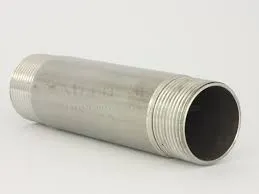-
Cangzhou Yulong Steel Co., Ltd.
-
Phone:
+86 13303177267 -
Email:
admin@ylsteelfittings.com
- English
- Arabic
- Italian
- Spanish
- Portuguese
- German
- kazakh
- Persian
- Greek
- French
- Russian
- Polish
- Thai
- Indonesian
- Vietnamese
- Zulu
- Korean
- Uzbek
- Hindi
- Serbian
- Malay
- Ukrainian
- Gujarati
- Haitian Creole
- hausa
- hawaiian
- Hebrew
- Miao
- Hungarian
- Icelandic
- igbo
- irish
- Japanese
- Javanese
- Kannada
- Khmer
- Rwandese
- Afrikaans
- Albanian
- Amharic
- Armenian
- Azerbaijani
- Basque
- Belarusian
- Bengali
- Bosnian
- Bulgarian
- Catalan
- Cebuano
- China
- China (Taiwan)
- Corsican
- Croatian
- Czech
- Danish
- Esperanto
- Estonian
- Finnish
- Frisian
- Galician
- Georgian
- Kurdish
- Kyrgyz
- Lao
- Latin
- Latvian
- Lithuanian
- Luxembourgish
- Macedonian
- Malgashi
- Malayalam
- Maltese
- Maori
- Marathi
- Mongolian
- Myanmar
- Nepali
- Norwegian
- Norwegian
- Occitan
- Pashto
- Dutch
- Punjabi
- Romanian
- Samoan
- Scottish Gaelic
- Sesotho
- Shona
- Sindhi
- Sinhala
- Slovak
- Slovenian
- Somali
- Sundanese
- Swahili
- Swedish
- Tagalog
- Tajik
- Tamil
- Tatar
- Telugu
- Turkish
- Turkmen
- Urdu
- Uighur
- Welsh
- Bantu
- Yiddish
- Yoruba

Oct . 11, 2024 06:25 Back to list
pipeline welding rods
The Importance of Pipeline Welding Rods in Modern Welding Applications
In the world of pipeline construction and maintenance, the quality of materials used plays a crucial role in ensuring the longevity and safety of the infrastructure. One of the most critical components in this process is the welding rod, specifically designed for pipeline welding. This article delves into the significance of pipeline welding rods, their types, applications, and the considerations necessary for successful welding operations.
Understanding Pipeline Welding
Pipeline welding is a specialized field that focuses on joining metal pipes used in various industries, including oil and gas, water supply, and sewage systems. The strength and integrity of these welds are essential to ensure that pipelines can withstand the pressures of transporting fluids and gases under varying environmental conditions. A well-executed weld can prevent leaks, reduce the risk of catastrophic failures, and ultimately save lives and resources.
Types of Pipeline Welding Rods
Welding rods come in different types and materials, each designed for specific applications and welding processes. Here are some common types of pipeline welding rods
1. E7018 This is a low-hydrogen electrode commonly used in pipeline welding. It provides excellent strength and ductility, making it suitable for welding high-strength materials. E7018 rods are often utilized in arc welding processes.
2. E6010 Known for its deep penetration and fast freezing characteristics, E6010 rods are frequently used in root pass welding. They are particularly effective for welding in difficult positions, and their versatility makes them a popular choice among welders.
3. E6011 Similar to E6010, E6011 rods are used for a variety of welding positions and conditions. They can be used with both AC and DC currents and are known for their ability to produce strong welds on dirty or rusty surfaces.
4. E308L This type of welding rod is specifically designed for stainless steel applications. E308L rods create corrosion-resistant welds and are commonly used in pipelines where resistance to chemical exposure is essential.
5. E316L Similar to E308L but with added molybdenum, E316L rods are used in corrosive environments, providing better corrosion resistance and strength at elevated temperatures.
Applications of Pipeline Welding Rods
pipeline welding rods

Pipeline welding rods are utilized in various applications, including but not limited to
- Oil and Gas Pipelines in the oil and gas industry are subject to high pressures and corrosive environments. The right welding rod selection is crucial for ensuring structural integrity and minimizing the risk of leaks.
- Water Supply Municipal water pipelines must maintain safe and reliable connections. Pipe welds must withstand constant pressure and potential soil movement, making the choice of welding rod paramount.
- Industrial Processes In industries like chemical processing, where pipelines transport harsh chemicals, the use of corrosion-resistant welding rods is essential to ensure the longevity of the infrastructure.
Considerations for Selecting Pipeline Welding Rods
When selecting the appropriate pipeline welding rod, several factors must be considered
1. Base Material The type of material being welded significantly influences the choice of welding rod. Different metals require different rods to achieve optimal weld quality.
2. Welding Position The position in which welding is performed can affect the type of rod selected. Some rods work better in certain positions (flat, horizontal, vertical, overhead) than others.
3. Environmental Conditions Factors like humidity, temperature, and exposure to corrosive elements should be considered when selecting welding rods to prevent premature failure of the weld.
4. Welding Process Different welding processes (MIG, TIG, SMAW) may require specific types of rods to achieve the best results, dictating the approach used in pipeline construction and repair.
Conclusion
Pipeline welding rods are essential components in ensuring the safety, functionality, and durability of pipeline systems. With an array of types designed for specific applications, selecting the appropriate welding rod is critical for successful welding operations. Understanding the characteristics and applications of these rods will empower welders to make informed decisions that enhance the structural integrity of pipelines, thereby contributing to the overall safety and efficiency of vital infrastructure. In a world where reliable transportation of resources is paramount, investing in quality welding materials cannot be overlooked.
Latest news
-
ANSI 150P SS304 SO FLANGE
NewsFeb.14,2025
-
ASTM A333GR6 STEEL PIPE
NewsJan.20,2025
-
ANSI B16.5 WELDING NECK FLANGE
NewsJan.15,2026
-
ANSI B16.5 SLIP-ON FLANGE
NewsApr.19,2024
-
SABS 1123 FLANGE
NewsJan.15,2025
-
DIN86044 PLATE FLANGE
NewsApr.19,2024
-
DIN2527 BLIND FLANGE
NewsApr.12,2024
-
JIS B2311 Butt-Welding Fittings LR/SR 45°/90° /180°Seamless/Weld
NewsApr.23,2024











